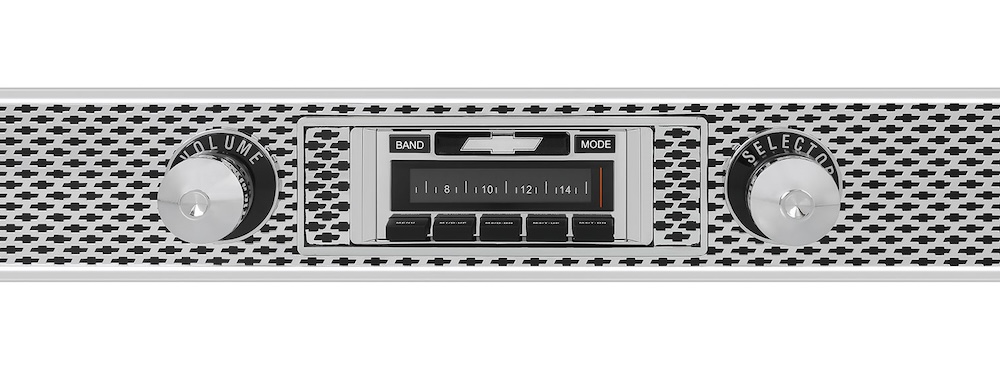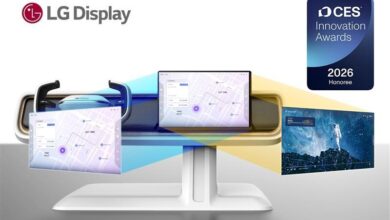Stereo Installs: Same Old Song & Dance?
Tips for selecting the right size & application for today’s builds...

This article originally appeared in the March 2024 issue of THE SHOP magazine.
What’s the first thing people do when they get into their cars? In most cases, they pick out the perfect song to listen to while they drive and then crank up the volume.
The right stereo can make all the difference, especially when someone is gearing up for a long road trip or taking a fun cruise in their classic vehicle.
As a stereo installation professional, you will often be asked what size stereo your customers should choose. To answer correctly, you’ll want to learn everything you can about in-dash and double-DIN stereos.
The following pointers can help you guide them through the process and ensure they make the right choice.
UNDERSTANDING THE BASICS
Let’s start with some basic information about these two options—in-dash and double-DIN stereos.
An in-dash stereo, as the name suggests, is a stereo that is built into the dashboard of a vehicle. In-dash systems may have a CD player, DVD player, AM/FM radio, satellite radio, Bluetooth connectivity, GPS navigation and/or a variety of other features.
Meanwhile, double-DIN stereos are a type of in-dash stereo, but they’re a bit more complex. DIN, by the way, is an acronym for Deutsches Institiut für Normung, which is a German standards organization.
“Double-DIN” (sometimes referred to as “2 DIN”) is a term that specifies a measurement. It’s the standardized size for a car stereo and measures 4 inches high and 7 inches wide.
By comparison, single-DIN stereos have a 2-inch opening and are also 7 inches wide.
SHOP-LEVEL CONSIDERATIONS
There’s no one-size-fits-all answer when it comes to making the most compatible choice for a particular vehicle. Everyone has different needs and preferences and there are a lot of awesome car stereos on the market.
Here are some factors to keep in mind on a shop level when helping a customer make a stereo selection.
Are they on a budget?
Because they offer fewer features, in-dash single-DIN stereos are typically more affordable than double-DIN options. If a customer has concerns about the price of their stereo, they might prefer a single-DIN option.
Do they want a touchscreen?
Touchscreens are convenient and found in many modern vehicles. They also integrate better with other features like back-up cameras.
Technically, your customers can have a touchscreen in their vehicle with any type of stereo. However, touchscreens are most commonly associated with double-DIN systems.
Because of their larger size, they simply work better—generally speaking—with touchscreen technology.
Are they a minimalist?
If the customer considers themselves a minimalist, or prefers a sleek interior, they might prefer an in-dash single-DIN stereo instead of a double-DIN option.
Single-DIN setups have more minimalist interfaces and can be easier to control, especially for those who get overwhelmed easily and don’t want to deal with as many extra (and potentially unnecessary) features.
Is their vehicle a classic?
The type of car will, understandably, influence the type of stereo it can accommodate.
For example, classic vehicles generally need in-dash single-DIN stereos. However, newer vehicles often come with, or are better equipped to work with, double-DIN systems because they have more advanced features.
Is device compatibility important?
If the customer cares about device compatibility and wants all their devices to integrate well with their vehicle’s stereo, a double-DIN stereo choice will likely be a better fit.
Many of these stereos can work with cameras, various phone apps, GPS navigation tools, etc.
Is sound quality important?
Both single- and double-DIN stereos can produce high-quality sound, so you can’t go wrong here. The more significant contributor to a customer’s sound quality is the brand and model of the head unit, also known as a receiver, that provides the main controls for the stereo.
You can introduce customers to a few different head units to help them decide which one works with their preferences, budget, etc.

MAXIMIZING PROFIT MARGINS
If you’re new to installing car stereos, you might have concerns about your profit margins and how to maximize them. Here are some tips that can help increase profitability:
Reduce SKUs
Some installers are tempted to keep a wide range of stereo options in stock—they go broad and shallow instead of narrow and deep.
It’s less expensive to keep multiple units of a couple different stereos in stock. This approach can help you expand your profit margins.
Charge a shop fee
A shop fee is a flat fee added to the cost of your services. It doesn’t have to be very high to be effective.
For example, if an installer charged all customers an hourly $7.49 shop fee and worked four hours per day, they’d profit roughly $9,000 a year just from the fees (assuming they worked 300 days per year).
Charge for materials
Make sure you’re charging for materials. Necessities like speaker wire can be quite pricey, and you shouldn’t have to pay for them out of your own pocket.
Change rates for luxury vehicles
If you’re working on a luxury vehicle, a classic car or another expensive model, make sure your rate reflects the added labor you’ll have to put in throughout the installation process (and the increased liability associated with working on more valuable vehicles).
Look for opportunities to upsell
Whether you like it or not, you are a salesperson in addition to a stereo installer. That means you should look for opportunities to upsell when possible.
Maybe offer to add speaker adapter rings for an extra fee, for example, allowing you to profit more from a sale than you would have otherwise.
FINAL THOUGHTS
As a professional installer, you will receive a lot of questions about what kind of stereo your customers should choose for their vehicle. It’s easy to get overwhelmed initially, no matter how knowledgeable you are.
Keep these guidelines in mind—especially those related to increasing your profit margins—to make your installation business more successful.
This article was provided by worldwidestereo.com. Learn more at worldwidestereo.com/blogs/guides/best-car-stereos.



